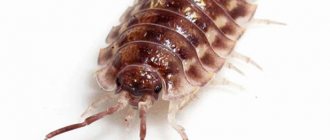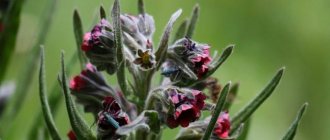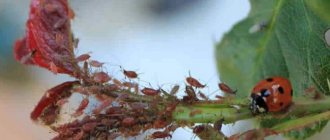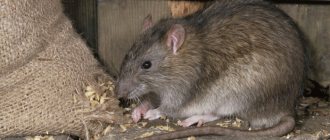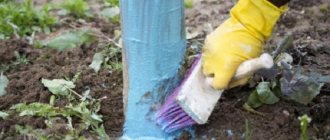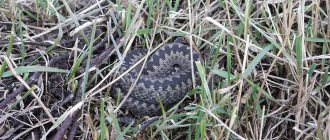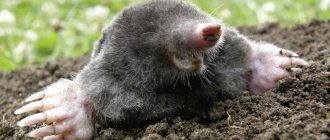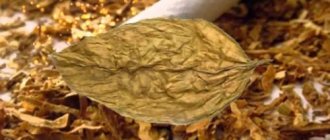Woodlice grass in cooking
Fresh woodlice grass is good for making purees; it can be added to first courses, baking fillings, and you can also use it to make vegetarian cutlets with buckwheat or oatmeal.
Salad with chickweed
To prevent vitamin deficiency and strengthen the body, a salad made from fresh wood lice, boiled eggs, green onions and seasoned with sour cream will be very useful.
Preparation:
- Chop chickweed and onion greens in equal parts.
- Add the chopped egg and add a little salt.
- Add sour cream and mix.
Decorate the vitamin salad with dill and serve.
Salad with dandelion and chickweed
Another vitamin salad, which is prepared with fresh herbs to prevent vitamin deficiency.
Preparation:
- Chop the woodlice greens and add half the amount of chopped lettuce and dandelion leaves.
- Add a little curdled milk, sugar, salt to taste and mix.
Chickweed seasoning
This healthy seasoning is served with fish and meat dishes.
Preparation:
- Woodlice - 200 grams, chop, add ground horseradish - 2 tbsp. spoons and crushed garlic - 1 tablespoon.
- Add salt and pepper to the seasoning to taste and stir.
Serve with meat or fish dishes.
Dumplings with woodlice
Ingredients:
- woodlice greens - 200 grams;
- wheat flour - 300 grams;
- onion - 1 head;
- ghee - 2 tbsp. spoons;
- half a glass of sour cream and salt.
Preparation:
- We make the filling - we wash the young woodlice shoots, cut them, add salt.
- Add fried onions and 2 raw eggs. Mix the filling.
- Knead and roll out the dough.
- Make dumplings and cook them in salted water.
Serve the dish with sour cream.
Scrambled eggs with woodlice
Ingredients:
- woodlice - 150 grams;
- eggs - 3 pieces;
- one onion, herbs, salt, ghee.
Preparation:
- Scald the woodlice greens with boiling water and chop them.
- Fry the onions a little in a frying pan.
- Add woodlice, dill, parsley and melted butter to the onion.
- Add salt and simmer everything under the lid.
- Then pour in the eggs, mix and fry until done.
Borscht with woodlice
Summer borscht with woodlice, a tasty and healthy dish.
Ingredients:
- woodlice grass - 100 grams;
- beet tops - 100 grams;
- carrots - 1 piece;
- potatoes - 1 large potato;
- a medium bunch of green onions, a few leaves of parsley;
- tomato - 1 piece or 1 tbsp. spoon of tomato paste;
- lemon juice - 1 teaspoon;
- sugar - 1 teaspoon;
- sour cream - 2 tablespoons.
Preparation:
- Put 1 liter of water on the fire.
- While the water is boiling, peel the carrots, potatoes, beets and chop them finely.
- Place the chopped vegetables in boiling water and cook for 10 minutes.
- Cut the tomato, sauté and add to the borscht.
- Cut the washed beet tops, sauté, add lemon juice, sugar and dip into borscht.
- Finely chop the washed wood lice and add to the borscht, salt the dish to taste.
When serving, season the borscht with finely chopped parsley and onion, add sour cream.
What is it and a brief botanical description
Woodlice or chickweed (Stellaria media) belongs to the class of dicotyledonous herbaceous plants of the Clove family. It is annual. The plant is also popularly called canary grass, wood lice, heart grass, midge grass or hernia grass.
This herb received the name “woodlouse” for its stem covered with thin hairs and cilia located on the edges of the leaves, which, when touched, leave moisture on the palms.
The plant likes to be located in dark places near houses, in vegetable gardens, feels good in wet fields and forest areas, and can also be found in ditches and ravines. Prefers loose and moist soils. Blooms from May to September.
During the season, one plant leaves up to 15 thousand seeds in the soil. Seeds can remain viable for up to 5 years. Reproduction occurs vegetatively by rooting stems.
You can use woodlice to predict the weather: if its flowers do not open at sunrise and remain closed all day, it means it will rain.
Contains a lot of carotene and ascorbic acid. In cooking, chickweed in its raw form is added to salads, and in boiled form - in borscht and main courses.
Due to its long flowering period, woodlice is considered a good honey plant. As a medicinal plant, woodlice is used in folk medicine and homeopathy (you can learn about contraindications and beneficial properties of woodlice here).
Animals happily consume it. It is recommended to add this herb, most valuable in its biological properties, to the feed of pigs, chickens and pigs daily.
↑ Chemical composition of woodlice
Herbalists are in no hurry to remove this weed from their gardens. They explain their reluctance by the fact that woodlice can be used to treat many diseases, for cooking, and for skin and hair care. This herb has a neutral taste and goes well with various spices and foods. But the main value of chickweed is its medicinal properties.
Morushnik has a rich composition of useful micro- and macroelements, as well as acids and vitamins. The high value of the herb is due to the content of ascorbic acid. Starwort also contains the following elements:
- lipids;
- phytoncides;
- tannins;
- essential oils;
- flavonoids;
- vitamins B, A, K, E;
- alkaloids;
- vegetable wax;
- silicon, iodine, selenium, magnesium, cobalt, copper, iron, phosphorus;
- gamma-linoleic acid.
Morose leaves contain tripertenic saponins.
Good to know: the unique medicinal properties of meadowsweet will help improve your health
Description of woodlice grass
Many people know what woodlice looks like. The official name of this herb is chickweed. It is named because as it grows, small white flowers appear on it, which in appearance resemble stars. The plant lives on average for about a month and can reach 30 cm in height.
The leaves of the woodlice are oval, slightly pointed at the tips. The stems are branched and covered with sticky fibers that retain moisture. The root is thin. During the period of its development, the plant throws out about 20 thousand kidney-shaped seeds. They retain their ability to sprout up to 30 years. That’s why it’s so difficult to fight weeds in the garden beds. Woodlouse doesn't give up without a fight.
Because of its structure, woodlice remains moist even in the hottest weather, the leaves shine in the sun, which is why it got its name. Some advanced summer residents, after removing this weed, use it as mulch, hoping that a lot of moisture will remain in the soil underneath it.
Chickweed (woodlice) has many beneficial properties. Unfortunately, not everyone knows this and after weeding they throw the grass into the compost heap. Although it is most reasonable to leave some of the green mass for use as an additive to salads or as a medicinal herb.
It’s worth warning right away that this herb has relatives that are not so beneficial for the body:
- Forest chickweed.
- Chickweed.
- Chickweed lanceolate.
Poultry are very fond of pecking woodlice. It is also useful for livestock. It has been noticed that if this weed is added to the feed of cows, they give more milk.
Common woodlice is found not only in garden beds, but also in forests and forest edges. You should not collect grass that grows along roads, since there the plant quickly absorbs numerous toxins. For Russian citizens, it will not be difficult to find wood lice, since it grows almost everywhere.
Harvesting and storing woodlice
Chickweed blooms all summer from May to August. For medicinal purposes, it is best to collect the herb in May; it is at this time that it is the most juicy, fresh and healthy. The entire green part of the plant is collected.
It is better to dry it in the shade, turn it over and shake it every day. Canvas bags are best suited for storage, but you can also store them in glass jars. Dry grass retains its medicinal properties throughout the year.
If you need fresh herbs all year round, you can freeze chickweed. Chop the green sprigs, put them in a plastic container or freezer bag, and put them in the freezer.
On a note! If you want to know whether it will rain today, then look at the flowers of the plant at about 9.00 in the morning; if they are closed, then it is raining.
Use in cooking
Russian peasants have been using woodlice as a food product for a long time. As soon as spring began, there was a need for products that could compensate for the lack of vitamins. Mokrichnik was an ideal option in this regard. They cooked green cabbage soup with it and added it to other dishes. This helped fight the traditional spring vitamin deficiency in the village.
Today there is no such urgent need to replenish the lack of nutrients in the body with the help of ordinary herbs. However, modern people can also eat it. There are several recipes:
- Vitamin cocktail. 250 g of fresh herbs and 50 g of chopped horseradish need to be infused for 4 hours in two liters of chilled boiled water. After this, the infusion is filtered, honey is added to it.
- Tonic drink. Take two apples, the same number of tangerines, 2 glasses of water and a handful of chickweed. All this is scrolled in a blender.
- Vitamin salad. Wood lice leaves, green onions and chopped boiled eggs are mixed and poured with sour cream. It is better to salt the salad.
- Salad No. 2. You need to chop and mix carrots, garlic and fresh chickweed. All this is filled with vegetable oil or sour cream, you need to add a little salt.
- Salad No. 3. Take onion, dill, parsley, red onion, 2 boiled eggs, 100 g each of chickweed and beet tops. All this should be chopped, salted and poured with sour cream.
Woodlice, despite its appearance, is a storehouse of vitamins and other useful substances. It will be good both when added to food and in your home medicine cabinet.
Uses of the woodlice plant
Medicinal properties
It can be used as a medicine to relieve pain; as a sedative herb for those who suffer from insomnia and neuroses; as a blood stopper; cholagogue, sputum expectorant.
You can make a calming tea using this recipe:
1 tablespoon is poured with boiling water and left for about five minutes. Drink 100 ml three times a day.
Woodlice in cosmetology
for face
Woodlice nourishes and saturates the skin with nutrients. The herb needs to be ground and applied to the entire face for about twenty minutes. Very useful for acne, easily fights them and moisturizes the skin. Suitable even for oily skin.
grass baths
Relieves any fatigue from the body and saturates the body with light vigor and freshness, fills with energy and at the same time calms. All this thanks to a decoction of herbs and boiling water, left for about two hours.
We fight calluses and cracks
Place some grass on your feet and put on your socks.
Woodlice in folk medicine
- Arthritis
A liter of boiling water + 4 tablespoons of salt + grass. Use this mixture to make ice cube trays using the freezer. Use ready-made ice cubes to wipe your feet and then wrap your feet warmly.
- Diabetes
- Cold
Effectively fights colds by cleansing the body of germs. Woodlice has an anti-inflammatory effect.
Woodlice in cooking
- Moist puree
It will be ideal with mashed potatoes. You need to use fresh leaves. Then pour boiling water and simmer with any herbs until tender.
It is important to know: the most important beneficial substances are preserved only in unprocessed form, that is, fresh
- Woodlice and carrot salad
Finely chop the carrots and add a little woodlice herb, add butter and sour cream to taste. Also with spices.
- Wet scrambled eggs
We use 3 eggs, grass, herbs and milk. Onions and other vegetables if desired. Mix everything and fry in oil.
- Moist seasoning
Even a seasoning is made from this herb. We will need 200 grams of herbs, horseradish, garlic and salt. Crush everything and sprinkle on dishes when cooking.
How is chickweed treated?
The plant is perennial (less commonly, annual). This plant has creeping shoots, although there are also varieties of chickweed that lack them. The stems are tetrahedral and can be either hairy or bare. The length of the stems is 10–30 cm. The leaves are sessile or almost sessile. have an ovoid or linear-lanceolate shape.
The diameter of the flower is about 20 mm, its shape is regular, bisexual. White color. The number of sepals is 4-5. The fruit of chickweed is a multi-seeded capsule with a cylindrical shape. The seeds of the plant are round and brown in color. The flowering period is very long, it begins in late spring and ends in autumn.
Habitat: fields, forests, meadows, vegetable gardens. Chickweed is widespread throughout our planet.
- Woodlice has choleretic and diuretic effects. It has the following healing properties:
- anti-inflammatory;
- painkillers;
- immunostimulating;
- wound healing;
- regenerating.
- Compresses and baths made from woodlice relieve joint pain due to arthritis, arthrosis and osteochondrosis.
- Juice and tea from the weed are used to treat the thyroid gland: they alleviate the symptoms of nodular and toxic goiter of the thyroid gland.
- The infusion and juice of the herb are used in folk recipes for the prevention and treatment of oncology of various localizations.
- Eye drops are prepared from woodlice. They help with the following ailments:
- with initial clouding of the cornea;
- for glaucoma;
- with cataracts.
- Chickweed juice increases lactation; mastopathy and mastitis are treated with compresses from steamed herbs.
- Tampons with woodlice decoction will alleviate the following female diseases:
- fibroids;
- cyst;
- cervical erosion.
- Lotions with a strong infusion of the herb help against skin ailments - rashes, acne and boils.
- Warm baths with woodlice decoction relieve swelling of the limbs, relieve pain from rheumatism, sprains and radiculitis.
- Woodlice is a remedy for scurvy.
Woodlice compensates for the lack of nutrients.
- Vitamin C restores thyroid secretion and stabilizes the production of pancreatic juice in the pancreas.
- Ascorbic acid is responsible for protein synthesis:
- Collagen, the basis of connective tissue. It is responsible for the strength of the skin and joints.
- Immunoglobulins are antibodies that resist threats that enter the blood.
- Interferon, which makes cells immune to viruses.
- Vitamin C regulates the functioning of neurotransmitters that transmit signals between neurons in the brain. He is responsible for production:
- adrenal hormones;
- cholesterol;
- bile in the liver.
- The carotene pigment becomes vitamin A in the body. By preventing the formation of atherosclerotic plaques, it reduces the likelihood of stroke.
- Carotene and vitamin E strengthen the immune system, prevent cancer and early aging.
- Triterpene saponins increase cell permeability and have an expectorant effect.
- Alkaloids are responsible for stimulating the nervous system and act as follows:
- as a diuretic;
- as a pain reliever.
- Tannins fight inflammation and bacteria and stop bleeding. They remove heavy metals from the body.
- Microelements are responsible for metabolism. Magnesium plays the following roles:
- promotes cell regeneration;
- calms muscles and nerves;
- helps absorb vitamins C, B1 and B6;
- preserves bone structure and strength.
- Iron is involved in the synthesis of immune cells and hemoglobin, which saturates tissues with oxygen.
- Tissue development depends on copper. It delivers iron to cells and participates in the synthesis of:
- proteins;
- enzymes;
- red blood cells;
- leukocytes.
- Cobalt is responsible for bone growth and protects the nervous system from overwork. It participates in the synthesis:
- red blood cells;
- thyroid hormones;
- pancreatic hormones.
- Essential oils have bactericidal, anti-inflammatory and healing effects.
Why is it useful?
Its favorite places to grow: vegetable gardens, orchards, damp forest clearings and heaps of garbage.
You can recognize the grass by its ovoid, pointed leaves and small white star-shaped flowers, for which botanists nicknamed this plant average chickweed.
The grass is called woodlice for its amazing ability to always remain moist and juicy even in dry weather.
More experienced summer residents do not consider woodlice a weed and are in no hurry to get rid of it. They use it as an excellent natural mulch that can protect the earth from drying out.
The soil under the grass always remains moist. Woodlouse is also an accurate meteorologist. If the flowers of the plant remain closed until 9 o’clock in the morning, it means it will soon rain.
Poultry love weeds. It’s not for nothing that people call it canary grass and bird’s lettuce. By regularly eating woodlice with great pleasure, chickens feel great and their egg production increases.
For some time now, folk healers have become interested in this plant, and then scientists have discovered in it a storehouse of useful substances that have a beneficial effect on the human body.
How to prepare a quick-acting children's laxative at home is written in this article.
Woodlice contains:
- vitamins C, E and K,
- carotene,
- organic acids,
- alkaloids,
- tannins,
- potassium salts,
- saponins,
- flavonoids,
- phytoncides,
- lipids,
- essential oils.
Chickweed is rich in valuable minerals: zinc, iron, boron, copper, magnesium, cobalt.
Woodlouse fully possesses:
- painkillers,
- anti-inflammatory,
- soothing,
- expectorant
- hemostatic,
- choleretic effect.
Thanks to its rich composition, the plant replenishes the body’s reserves of missing vitamins and microelements and helps in curing many ailments. Miracle weed:
- increases immunity and has a general strengthening effect;
- promotes recovery from colds, bronchitis, pneumonia and other pulmonary diseases;
- relieves pain from bruises, dislocations, sprains, rheumatism, arthritis and other joint diseases;
- has a calming (woodlice is part of soothing herbal teas) and strengthening effect on the nervous system;
- useful for anemia and general loss of strength;
- has a beneficial effect on the heart, improves its performance, relieves heart pain;
- helps with kidney diseases (symptoms and treatment of pyelonephritis in women), liver, thyroid gland, eye diseases;
- eliminates cramps and pain in the stomach, helps with flatulence, constipation and hemorrhoids;
- activates hemoglobin production;
- promotes the healing of purulent and long-term non-healing wounds;
What do you know about the beneficial properties and contraindications of cedar oil? Several recipes and recommendations for use are written in a useful article.
What helps against alcohol poisoning is written here.
treats pustular skin lesions, ulcers, eczema; helps in the treatment of mastopathy, stimulates lactation in nursing mothers; used in the treatment of enuresis in children; cleanses and heals the skin, fights acne.
Useful properties of the herb midge
- fresh plant juice is recommended for the treatment of the gastrointestinal tract and various digestive problems;
- The plant is also invaluable for those who have disorders in the cardiovascular system, internal bleeding, and thyroid disease;
- an infusion of the herb midge can normalize the water-salt balance in the human body, and with regular use, maintain it at the level necessary for good health;
- Fresh chickweed juice is also used in ophthalmology - it is instilled into the eyes for clouding of the pupils and iris;
- It is recommended to use the decoction for those who suffer from nervous exhaustion; the “medicine” has a weak sedative effect, and in addition it also cleanses the blood of waste and toxins;
- Taking baths with chickweed infusion helps get rid of joint pain and relieve severe muscle tension.
A decoction or infusion of the plant is extremely useful for diseases of the female genital area (erosion), it is worth considering that the frequency of taking the infusion (50 ml) should correspond to the diet and food intake.
Chickweed has virtually no taste when fresh, so young leaves can be added to various vitamin-rich salads. Such salads are very useful for men and increase male potency in adulthood.
To prepare an alcohol tincture you will need:
- 50 g of fresh chickweed leaves (or 25 g of dry raw materials);
- 300 ml vodka.
Mix everything in a wide-necked bottle and leave for 15 days, shaking regularly. It is recommended to infuse in a dark place, strain and store in the refrigerator.
To prepare the infusion you will need:
- 2 tbsp. spoons of dry raw materials;
- 2 glasses of water.
Midge, or chickweed, is an annual plant from the Clove family, which many gardeners consider their worst enemy. Numerous seeds quickly spread throughout the area and retain…
Midge, or chickweed, is an annual plant from the Clove family, which many gardeners consider their worst enemy. Numerous seeds quickly...
Woodlice grass, a photo and description of which is presented in our article, its properties and methods of use are little known to gardeners, because many of them mistake the plant for a weed and try to get rid of it.
How to identify a pest
Woodlice and silverfish are equally unpleasant to look at and equally not parasites of humans. They can be pests, nothing more.
This type of symbiosis between humans and small arthropods is called commensalism, its essence is that a person receives neither harm nor benefit from them, but the “settlers” will always find food next to a person.
Woodlice are small crustaceans, and silverfish are from the class of insects.
Woodlice have an oval and convex body 10-15 mm long; its shell and long mustache are clearly visible.
Their usual habitat is wildlife; in an apartment they have to live in the toilet and bathroom - where there is the most moisture. They mostly feed on plants and decaying organic matter.
Silverfish have an elongated, elongated body. As well as long antennae and several curved tails at the back of the body. Color silver, black, greenish, colorless.
Individuals can grow in size from a few millimeters to 1.3 cm. They feed on organic debris and love cellulose (they can be found on books and near paper wallpaper). They readily eat any fabric and can damage clothing.
Read here How to get rid of ants: reasons and methods for how to permanently remove ants with your own hands (105 photos)
Both of them make you want to get rid of them, no matter how harmless they may seem. And the methods of fighting against both species will be similar.
Medicinal properties of woodlice herb in folk medicine
Woodlice can often be found in preparations intended for the treatment of gynecological and cardiovascular diseases. In addition, it can be used as an independent remedy for the overall health of the body. Chickweed is useful for the following properties:
- disinfectant effect;
- expansion of the vascular cavity;
- pain relief;
- activation of immune defense;
- removal of mucus from the respiratory organs;
- laxative and diuretic effects;
- increased blood clotting;
- toning muscles;
- acceleration of regenerative processes;
- starting metabolism;
- treatment of skin diseases;
- increasing the level of hemoglobin in the blood.
The healing properties of woodlice herb for joints
According to statistics, woodlice grass effectively treats joint diseases. It helps restore bone joints and relieves swelling of tissues. Woodlice is prescribed in the presence of pronounced pain and inflammation. Direct indications for its use include gout and the postoperative period. Treatment of joints is carried out using tincture of medicinal herbs. Compresses are prepared from it and applied to the problem area.
For the thyroid gland
The medicinal plant chickweed is especially popular in the treatment of the thyroid gland. It contains iodine and useful elements necessary for its absorption. The herb is often used to eliminate hyperthyroidism. The disease is accompanied by a lack of iodine due to impaired absorption. The components in woodlice improve the functionality of the organ and eliminate the accompanying symptoms of pathology. To do this, take 1 tsp of herb juice. 1 time per day. Take before meals. Treatment lasts at least 3 weeks.
For children
Woodlice helps children cope with urinary incontinence during sleep. In this case, they practice taking a herbal decoction or putting steamed herbs in socks. For bruises and sprains, the herbal paste is applied to the problem area in the form of a compress. This helps relieve pain and eliminate swelling. However, this treatment method is contraindicated for open wounds.
↑ Dosage forms produced by pharmacists
You can buy dry woodlice herb at the pharmacy to prepare medicinal drinks, decoctions and tinctures at home. The dried raw materials are placed in cardboard packages weighing 30, 50, 100 g. Other types of medicines with woodlice are also produced:
- "Shchitovit."
The drug contains, in addition to woodlice, brown algae, bloodroot, and tyrosine. Used in the treatment of thyroid pathologies as an adjuvant. - Tincture.
Alcoholic extract of chickweed is produced in dark bottles from 30 to 100 ml. Application both external and internal. - Chickweed in tablets.
The product is produced in jars with gelatin capsules that contain crushed grass. The drug is classified as a food additive. Recommended use as a prophylaxis to increase immunity during cold epidemics. - Woodlice juice.
It is packaged in containers of 50-200 ml. The juice is used for eye pathologies, as well as for compresses. - "Endocrinol"
. The drug belongs to the dietary supplements. It contains vitamin E, woodlice, and cinquefoil. Used for the treatment and prevention of endocrine diseases.
Chickweed is a weed that many summer residents and gardeners are trying with all their might to remove from the site. The main reason is the rapid spread of grass throughout the area. But herbalists and doctors classify the plant as medicinal. Infusions, teas, ointments, decoctions and oil with morushnik help protect against various diseases, eliminate the likelihood of complications in acute diseases, and reduce the risk of symptoms in chronic pathologies.
Harm from using chickweed can only occur if the dosage is not followed and the dosage is exceeded.
Woodlice: use in folk medicine
The herb, both fresh and dried, is suitable for preparing medicinal products. Decoctions, infusions, and tea are made from it.
Chickweed tea
It is recommended to drink for prevention; it has a calming and restorative effect.
What you need: Pour 200 ml of herbs into a full tablespoon. boiling water, let it brew for 5-7 minutes. You can take 100 ml instead of regular tea. three times a day.
Woodlice for eyes
To treat diseases of the retina and cornea of the eye, you can prepare drops from fresh herbs.
Infusion for the eyes
What you need: Pour 200 ml of chopped fresh herbs into a tablespoon. boiling water Let it brew for an hour, strain well. Apply the resulting infusion to your eyes 3 times a day, 1-2 drops.
Juice for the eyes
Do: Rinse well with about 500 gr. plants, squeeze out the juice using a juicer or chop the grass, mash with a masher, then squeeze out the juice through 2-3 layers of gauze. Pour fresh juice into a glass bottle and store in the refrigerator for no more than two days. It is recommended to instill eye drops 4 times a day, 1-2 drops.
On a note! Fresh juice is suitable for treating purulent wounds; you can lubricate pimples and acne at least 4 times a day.
To relieve fatigue and pain in the legs
All summer residents probably know this simple recipe. You just need to pick fresh grass and put it in your shoes instead of insoles.
You need to walk all day, before going to bed, wash your feet and lubricate them with rich cream. In this way you can treat dry calluses and cracked heels.
Woodlice tincture for the stomach
What you need to do: Pour a tablespoon of the herb with good vodka (300 ml), let it brew in a dark place for at least two weeks. Take only diluted, 20 drops per glass of clean water, drink before meals.
Woodlouse for women
To produce breast milk
Do: Mix fresh plant juice (see recipe above) with good honey in equal proportions. Take a teaspoon three times a day before meals.
For the treatment of erosion, cysts and uterine fibroids
Do: Boil 2 tablespoons of herbs in 0.5 liters of water in a water bath for about 30 minutes. Then strain the broth and add boiled water to the original volume. Take 50 ml. 4 times a day before meals.
Additionally, it is recommended to insert a tampon soaked in the broth into the vagina at night for five days, then take a break for five days. Repeat this procedure until complete healing.
It is recommended to take the decoction 10 days before the start of menstruation to relieve pain and solve the problem of delays.
On a note! This decoction can be taken for anemia, dizziness, and strengthening the body.
For mastopathy, pour boiling water over fresh herbs, cool, and apply to the sore breast.
For the treatment of skin diseases
What you need to do: Pour a glass of boiling water over one tablespoon with a heap of herbs (dry or fresh), let it brew for at least four hours, strain through gauze.
Wash non-healing wounds with the prepared infusion, apply compresses to problem areas of the skin (for eczema and ulcers) at least twice a day.
On a note! This infusion can be taken ¼ cup 4 times a day for joint pain and strengthening the nervous system.
Chickweed decoction for the treatment of dermatological diseases
You need to: Pour 4 tbsp. spoons with one liter of water, bring to a boil, simmer over low heat for 5 minutes, let steep for at least two hours. Strain through gauze. Use as compresses for problem areas of the skin.
On a note! The decoction can be used to treat cracked heels, wipe the face with very oily skin and to prevent skin aging.
For the treatment of joints
It is recommended to make lotions from the fresh juice of the plant on the sore spot. To enhance the effect, you can drink fresh juice with honey (see recipe above) a teaspoon four times a day.
For the treatment of the thyroid gland
Herbalists also recommend taking fresh juice with honey 4-5 times a day, or a decoction of 1/3 cup 30 minutes before meals. The course of treatment can be at least six months.
Application
In folk medicine, several variations of recipes with woodlice herb are common. The ratio of ingredients in each of them varies. Accordingly, the concentration of constituent substances will also differ. In addition, alcohol-containing compounds retain their beneficial properties for a longer time. When choosing a remedy, it should be taken into account that the tincture is contraindicated for diseases of the liver, kidneys and gastrointestinal tract.
Treatment with woodlice has a cumulative effect. During therapy, your health should be monitored by regular testing.
It is equally important to follow the dosage and dosage regimen
Woodlice decoction
Most often, a decoction of the herb is used for oral use. It activates the body's defense mechanisms and accelerates the process of cell and tissue regeneration
During treatment, it is extremely important not to exceed the permissible dosage. This may lead to poisoning
Components:
- 2 tbsp. l. woodlice grass;
- 200 ml water.
Cooking steps:
- The raw materials are poured into deep containers and filled with water. After boiling, the drink is kept on fire for 10 minutes.
- The finished medicine is further infused under the lid for 30 minutes.
- Reception is carried out at ¼ tbsp. 3 times a day.
The concentration of nutrients in the decoction is higher than in the infusion.
Infusion
Ingredients:
- 1 tbsp. l. dried herbs;
- 200 ml water.
Cooking process:
- The woodlice is poured with hot water and left to infuse.
- After 25 minutes, the resulting product is carefully filtered.
- It should be taken 100 ml 3 times a day.
Before use, the wood lice must be washed
Juice
Woodlice juice helps with lack of appetite and general physical weakness. It is recommended for use during the recovery period after protracted illnesses. Honey as part of a medicinal product increases the immunomodulatory effect. The juice is obtained by grinding fresh herbs in a blender. It is mixed with honey in equal proportions. The finished composition is taken 1 tsp. 3-4 times a day.
Chickweed juice is called the elixir of life
Tea
To prepare tea, you should brew the chickweed herb for no more than 5 minutes. This is enough for the plant to release the required amount of nutrients into the water. Both dried and fresh herbs can be used as the main ingredient.
Chickweed tea can be purchased at a specialty store or pharmacy.
Baths
Baths with the addition of woodlice decoction are excellent for cardiovascular diseases and treat skin lesions. It is enough to add 1-2 liters of medicinal decoction to the bath. The duration of the procedure is 20-30 minutes. The general course of treatment depends on how advanced the disease is.
Compresses
Compresses with woodlice are effective against ophthalmic diseases, bruises and joint pain. To prepare them, you need to steam a small amount of herbs. Then the thicket is carefully drained and applied to the problem area. The duration of exposure depends on the scale of the problem. The compresses are kept on the eyes for 10 minutes, and on the joints for several hours.
The advantage of compresses is the quick effect
Advice! Before using a medication, it is extremely important to ensure that there is no allergic reaction.
Ointments
Woodlice ointment is excellent for treating burns and joint diseases. It is prepared in a water bath. The medication should be stored in the refrigerator. Taking the product internally is strictly contraindicated. It is applied to problem areas of the skin 2 times a day.
Components:
- 50 ml vegetable oil;
- 40 g dried woodlice;
- 40 g cocoa butter;
- 40 g beeswax.
Cooking steps:
- The components are placed in a container and placed in a water bath.
- It is necessary to stir the mixture periodically until the components are completely dissolved.
- When the mass becomes homogeneous, remove it from the heat and cool to room temperature.
Chickweed ointment has anti-inflammatory and regenerating effects
Description of appearance
Woodlice is a crustacean creature that lives in damp areas. A terrestrial creature located in a place with high humidity.
- The oblong body of a convex shape is divided into segments. Adults have 7 of them.
- There are two pairs of antennae on the head. The first ones are short, poorly developed, the second mustaches are long. This is the main organ that helps the insect navigate in space and look for a food source.
- The structure of the woodlice is simple. There are 7 pairs of straight legs on the sides, ensuring fast movement. The sixth pair of limbs faces backward, helping the insect to quickly change direction of movement. How many legs a woodlice has depends on its age. Adults have 7 pairs, while larvae have only 6.
The first 5 segments of the body are free, overlapping each other like tiles. Their internal part plays the role of gills - respiratory organs. The upper part protects the body and is a hard shell. Insects breathe with the middle part of the body, the respiratory organs are simplified. The last segment ends with a long tail. In some species, the whiskers and tail look the same; it is difficult to determine where the beginning and end of the body are.
The size of woodlice is no more than 18 mm. Body color may vary depending on the species and age. The color is gray, ash, white, brown. The larvae are always lighter than adults and are born with a white shell. A photo of the woodlice is shown below. You can carefully examine every part of the body.
Interesting!
It is difficult to determine by appearance whether it is an insect or not. Some call the crustacean a harmful bug. Experts, answering the question of what woodlice are, classify them as crustaceans. In everyday life, they are used to calling them insects, without really looking closely at the structure of the body and the features of their vital functions.
woodlouse
Photo and description
Woodlouse (Stellaria media) is an annual herb, also called chickweed, and represents the class - dicotyledonous herbaceous plants, family - Cloveaceae. It also has such popular names as woodlice, canary grass, midge, hernia grass, heart grass.
The grass has a branched stem creeping along the surface of the soil with oblong, rounded leaves. The stem has fine hairs, and the edges of the leaves are covered with moist cilia, which is how the woodlice got its name. The flowers of the plant are white, shaped like stars, which is why the grass is also called chickweed.
Flowering of woodlice begins in May and continues until August, after which the fruit appears in the form of a dark brown box. It contains seeds that ripen from mid-summer to October. During this time, the box opens from time to time.
Where does it grow
You can meet woodlice mainly in the garden, in a vegetable garden or farmstead, on the banks of a river or stream, on the side of the road or at the edge of a forest. The plant prefers moist soil and likes to be located near an open body of water, which provides it with ideal growing conditions.
Difference from a similar poisonous grass
Woodlice has a significant resemblance to the poisonous herb lanceolate chickweed, which also has a name - forest chickweed or stiff-leaved chickweed. It differs from useful grass in that it is a perennial plant and has a thin creeping rhizome. In turn, woodlice is an annual plant that leaves behind multiple viable seeds.
Both plants belong to the genus Chickweed and have similar flowers, while at the same time differing in leaves. Chickweed lanceolate leaves have a pointed shape, while chickweed has rounded leaves. Before the end of flowering, the length of chickweed lanceolate is up to 0.3 (sometimes up to 0.6 m). The size of woodlice is significantly smaller.
Interesting fact about woodlice
The plant is known for its ability to predict the weather, as it is sensitive to air humidity and ambient temperature. Previously, people used woodlice as a barometer to predict the weather for the coming day. It has been noticed that if the flower of a plant does not open in the morning by 9 o'clock, it will be rainy. Rain, wetting the woodlice, makes it look like crystal, thanks to the stems shining under the sun, filled with moisture during precipitation. This may have been the reason for calling the plant woodlice.
Composition of woodlice
Traditional medicine justifiably recommends the use of woodlice to treat various diseases. After all, the composition of the plant is rich in many healing components.
Woodlice is rich:
- vitamins C, E and K;
- organic acids;
- alkaloids;
- flavonoids;
- tannins;
- carotene,
- essential oils;
- phytoncides;
- lipids;
- potassium, iron, zinc, boron, copper, magnesium, cobalt.
Beneficial features
The grass chickweed is known for many beneficial properties, while its use has minimal contraindications. When used correctly, the plant has various positive effects on the human body:
- eliminates pain;
- reduces nervous tension;
- stops bleeding;
- relieves inflammation;
- removes phlegm and bile;
- accelerates the healing of skin damage;
- disinfects;
- constricts blood vessels;
- stimulates intestinal function;
- strengthens the immune system;
- tones;
- has a general strengthening effect;
- rejuvenates;
- removes excess liquid;
- improves metabolism;
- has a softening effect.
Contraindications
- Woodlice helps reduce blood pressure, as we have already discussed.
- Some people have an allergic reaction to certain types of herbs, including wood lice. If in doubt, apply a small dose of the product to the back of your hand to check for allergies.
Only in these cases are there any negative aspects of woodlice; mostly positive ones are observed. Before removing weeds, think about whether it has healing qualities, whether it can help somewhere. Woodlice can be found in a variety of places, even in landfills. It is because of these very unpleasant places that the plant is considered disgusting.
In another article we described calendula.
